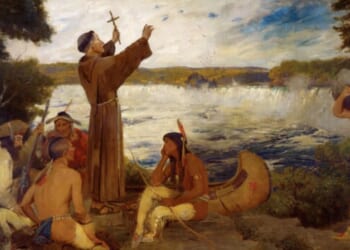In September of 1861, Thomas Meagher began recruiting Irishmen to form a new Irish brigade.
In honor of St. Patrick’s Day (known in Gaelic as Lá Fhéile Pádraig, i.e. “the Day of the Festival of Patrick”), a feast day which honors the Patron Saint of the Republic of Ireland and occurs on March 17, The National Interest is publishing a three-part St. Patrick’s Day special series on Celtic warriors.
We started by telling the story of El Batallón de San Patricio (“Saint Patrick’s Battalion”), aka the San Patricios, Irish immigrants to the United States who fought on the side of Mexico during the 1846 Mexican-American War. These Irish Americans deserted on account of the vicious anti-Catholic bigotry that infested the senior leadership of the U.S. Army (and much of American society in general, some of which sadly persists today) at the time. (We hasten to add that these deserters only comprised less than 4 percent of the Irish-born U.S. soldiers who served in that war.)
This time we’re staying in the nineteenth century, but we’re fast-forwarding two decades to a war wherein the Irish Americans were treated much better by the U.S. Army bureaucracy and reciprocated that loyalty in droves via their battlefield heroism: the legendary “Fighting 69th,” i.e., Meagher’s Irish Brigade of the American Civil War.
Brig. Gen. Thomas Meagher Mini-Bio
The Meagher in question was Brigadier General Thomas Francis Meagher (August 3, 1823-July 1, 1867), who was born in Waterford, Ireland. As a young adult, Thomas was a member of an Irish independence group known as the Irish Confederation, and for his troubles, he was convicted of sedition against the British Crown and was forcibly shipped to modern-day Tasmania, Australia. Luckily, in 1851, Meagher made his escape and arrived in New York City the next year, whereupon he was revered as a celebrity of Irish independence.
Long story short, in September of 1861—five months after the attack on Fort Sumter kicked off the Civil War—Meagher began recruiting Irishmen to form a new Irish brigade. That December, President Abraham Lincoln bestowed upon Meagher a tripartite Christmas gift: authorizing the Irish firebrand to not only recruit Irishmen from other states but also soldiers in Ireland to persuade the Irish to train for an Irish revolution, along with a promotion to Brigadier General for this new Irish Brigade.
This brigade would soon blast its way into the pages of history.
How Well Did Meagher’s Irish Brigade Fight?
Not surprisingly at all, and just like their predecessors in the Mexican-American War, they fought with bravery, ferocity, and tenacity, true to the Celtic warrior spirit, as personified in their battle cry of “Faugh a Ballagh (Clear the Way)!” The Irish Brigade fought in every major campaign of the Army of the Potomac, including Fredericksburg (where, as dramatized in the movie Gods and Generals, they fought against one of the Confederacy’s own Irish Brigades) and Gettysburg.
“We soon got into battle/We made a charge of bayonets/The Rebel blaggards soon gave way/They fell as thick as peanuts/Och hone, the slaughter that we made, bedad it was delightin’/For the Irish lads in action are the Divil’s [sic] boys for fightin’/For to fight for Uncle Sam/He’ll lead us onto glory-o, he’ll lead us onto glory’o/To Save the Stripes ‘n’ Stars”—“We’ll Fight for Uncle Sam” by David Kincaid
But it was during the Battle of Antietam of September 17, 1862, the deadliest one-day battle in American military history—The Bloodiest Day, to cite the title of Ronald H. Bailey’s excellent 1984 book on the subject—that the Irish Brigade truly cemented its reputation, both for its ability to take brutal punishment and to dish it out. As noted by the National Park Service:
“As it formed at the edge of a cornfield Father William Corby, Chaplain rode along the line, giving absolution to the soldiers. The 69th New York occupied the right then the 29th Massachusetts, the 63rd and 88th New York crossing the cornfield, the command encountered a rail fence which was torn down under severe fire an opposing Confederate column advanced within 300 paces of the brigade. After several volleys, the Irish Brigade charged with fixed bayonets. At 30 paces it poured buck and ball into General George B. Anderson’s Brigade (2nd, 4th, 14th and 30th North Carolina Infantry Regiments) which fell back to ‘Bloody Lane.’ After fierce combat its ammunition exhausted the Irish Brigade was relieved.”
Regarding that aforementioned “brutal punishment,” William F. Fox, in his 1889 treatise Regimental losses in the American Civil War, 1861-1865, noted that, of all the Union Arny brigades, only the 1st Vermont Brigade (aka, “The Old Brigade”) and the Iron Brigade suffered more killed in action than the Irish Brigade; eleven Brigade members were awarded the Medal of Honor over the course of the war.
Regarding the ability to dish out punishment, Confederate General Robert E. Lee lost one-fourth of his beloved Army of Northern Virginia at Antietam, and his officer corps was decimated. A goodly-sized chunk of those Southron casualties was on account of Irish Brigade bullets and bayonets at Bloody Lane.
Legacy and Tributes
My friend Justin Mayhue, retired battalion chief of the Hagerstown (Maryland) Fire Department, is now a superb battlefield tour guide for Antietam (and Harper’s Ferry for good measure). My personal favorite portion of Justin’s tour is the monument to the Irish Brigade, located at the base of the tower at Bloody Lane.
About the Author: Christian D. Orr
Christian D. Orr was previously a Senior Defense Editor for National Security Journal (NSJ) and 19FortyFive. He is a former Air Force Security Forces officer, Federal law enforcement officer, and private military contractor (with assignments worked in Iraq, the United Arab Emirates, Kosovo, Japan, Germany, and the Pentagon). Chris holds a B.A. in International Relations from the University of Southern California (USC) and an M.A. in Intelligence Studies (concentration in Terrorism Studies) from American Military University (AMU). He has also been published in The Daily Torch, The Journal of Intelligence and Cyber Security, and Simple Flying. Last but not least, he is a Companion of the Order of the Naval Order of the United States (NOUS). If you’d like to pick his brain further, you can ofttimes find him at the Old Virginia Tobacco Company (OVTC) lounge in Manassas, Virginia, partaking of fine stogies and good quality human camaraderie.
Image: Wikimedia Commons.















